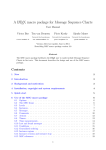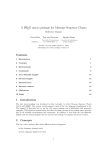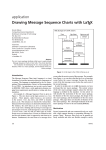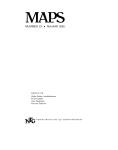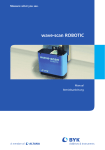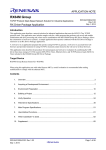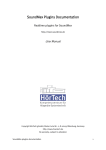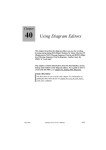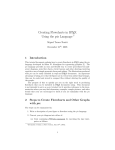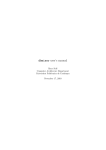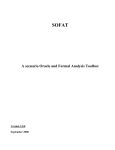Download A LATEX macro package for Message Sequence Charts
Transcript
A LATEX macro package for Message Sequence Charts User Manual Victor Bos [email protected] Ton van Deursen Sjouke Mauw Université du Luxembourg Université du Luxembourg [email protected] [email protected] Version 1.17, last update December 22, 2010 Describing MSC macro package version 1.17 Abstract The MSC macro package facilitates the LATEX user to easily include Message Sequence Charts in his texts. This document describes the design and use of the MSC macro package. Contents 1 New 2 2 Introduction 3 3 Background and motivation 4 4 Installation, copyright and system requirements 4 5 Quick start 5 6 Use 6.1 6.2 6.3 6.4 6.5 6.6 6.7 6.8 6.9 of the MSC macro package The MSC frame . . . . . . . . . Levels . . . . . . . . . . . . . . Instances . . . . . . . . . . . . . Messages . . . . . . . . . . . . . Comments . . . . . . . . . . . . Actions . . . . . . . . . . . . . Timers . . . . . . . . . . . . . . Time measurements . . . . . . . Lost and found messages . . . . . . . . . . . . . . . . . . . . . . 1 . . . . . . . . . . . . . . . . . . . . . . . . . . . . . . . . . . . . . . . . . . . . . . . . . . . . . . . . . . . . . . . . . . . . . . . . . . . . . . . . . . . . . . . . . . . . . . . . . . . . . . . . . . . . . . . . . . . . . . . . . . . . . . . . . . . . . . . . . . . . . . . . . . . . . . . . . . . . . . . . . . . . . . . . . . . . . . . . . . . . . . . . . . . . . . . . . . . . . . 7 7 7 8 9 10 11 12 12 14 6.10 6.11 6.12 6.13 6.14 6.15 6.16 6.17 6.18 Conditions . . . . . . Generalized ordering Instance regions . . . Instance creation and MSC references . . . Inline expressions . . Gates . . . . . . . . High-level MSCs . . MSC documents . . . . . . . . . . . . . . . . . . instance . . . . . . . . . . . . . . . . . . . . . . . . . . . . . . . . . . stop . . . . . . . . . . . . . . . . . . . . . . . . . . . . . . . . . . . . . . . . . . . . . . . . . . . . . . . . . . . . . . . . . . . . . . . . . . . . . . . . . . . . . . . . . . . . . . . . . . . . . . . . . . . . . . . . . . . . . . . . . . . . . . . . . . . . . . . . . . . . . . . . . . . . . . . . . . . . . . . . . . . . . . . . . . . . . . . . . . . . . . . . . . . . . . . . . . . . . . . . . . . . . . . . . . . . . 14 15 16 17 19 20 21 22 24 7 Style parameters 25 8 Example 29 9 Acknowledgments 30 1 New Version 1.17 slightly modifies the handling of the offset argument of the mess, setstoptimer, and settimeout commands. All commands with an offset argument can now properly handle real numbers as argument. Furthermore, the \topheaddist, \firstlevelheight, and \instheadheight lengths are now taken into account when computing the height of the instance and the \gatesymbolradius length is now properly implemented. The \condition* macro is now extended to dynamically resize a condition symbol that spans multiple instances. The \condition* and \action* macros, introduced in the previous release, no longer shrink to a size smaller than their non-starred counterparts. The \condition and \action have crossed-out counterparts \ncondition and \naction respectively. A variation to the \stop command is implemented. Rather than drawing a cross to denote that an instance has stopped, the \stop* command draws an instance footer. Finally, the \create command no longer requires the creator parameter to be specified. If it is not specified, no arrow is drawn from the creator to the dynamically created instance. Version 1.16 solves a bug that was due to a change in syntax of the scalebox macro in the PSTricks package. The action and condition macros are extended with a starred option. The starred version of the macros automatically adjusts the size of the rectangle and hexagon based on the size of the contents. 2 Version 1.13 has a reimplementation of message commands in MSC diagrams. The affected commands are: \create, \found, \lost, \mess, and \order. The new implementation provides more control over the placement of message labels. The command \selfmesslabelpos has been removed. The bounding box bug has been partly solved. Now, a white \fbox is drawn around every (msc, mscdoc, hmsc) diagram. This makes it possible for dvips -E to compute the correct bounding box for the diagrams. Due to the \fbox, each diagram is extended with 0.3pt on each side (left, top, right, and bottom). This bugfix fails if the background is not white. The xdvi program shows the white \fbox in black with the result that diagrams have two visible frames. This seems to be a bug of xdvi. The lines around comments (\msccomment, Section 6.5) are changed from gray into black. The reason for this is that the gray lines became invisible after converting the document to HTML. 2 Introduction The MSC language is a visual language for the description of the interaction between different components of a system. This language is standardized by the ITU (International Telecommunication Union) in Recommendation Z.120 [3]. An introductory text on MSC can be found in [5]. MSCs have a wide application domain, ranging from requirements specification to testing and documentation. An example of a Message Sequence Chart is in Figure 1. In order to support easy drawing of MSCs in LATEX documents, we have developed the MSC macro package. The current version of the MSC macro package supports the following MSC constructs: MSC frame, instances (both single line width and double line width), messages (including self-messages and messages to the environment), actions, singular and combined timer events (set, timeout, reset, set-timeout, set-stop), lost and found messages, generalized order, conditions, coregions, activation regions, suspension regions, gates, instance creation, instance stop, time measurements, references, and inline expressions. In addition, there is support for HMSC’s (high-level MSCs) and MSCdocs. In this manual we explain the design and the use of the MSC macro package. For a complete overview of all features, we refer to the reference manual [1], which is included in the distribution under the name refman.ps. Another way to learn how to use the MSC macro package is to have a look at the LATEX source code of the manual and the source code of the reference manual. They are included in the distribution under the names manual.tex and refman.tex, respectively. The MSC constructs are simply introduced as syntactic constructs. This paper is not meant to describe their use or meaning. We list the backgrounds of the package and some design decisions in Section 3. Section 4 contains notes on installing the package. Section 5 contains an example of using the package. It allows the impatient reader to quickly start using the package. The details of using the package are explained in Section 6. In Section 7 the parameters are explained which determine detailed layout of the various symbols. A large but meaningless example 3 is given in Section 8. 3 Background and motivation Several commercial and non-commercial tools are available, which support drawing or generating Message Sequence Charts. However, these tools are in general not freely available and often not flexible enough to satisfy all user’s wishes with respect to the layout and graphical appearance of an MSC. Therefore, people often use general drawing tools, such as xfig to draw MSCs. However flexible this approach is, it takes quite some effort to produce nice MSC drawings in a tool which is not dedicated to MSCs. Furthermore, when drawing a number of MSCs it requires some preciseness in order to obtain a consistent set of MSCs. For these reasons, we have started the design of a set of LATEX macros which support the drawing of MSCs. In this way, an MSC can be represented in LATEX in a textual format and compiled into e.g. PostScript. We aimed at satisfying the following requirements and design decisions. • The package should follow the ITU standard with respect to shape and placement of the symbols. (The current version supports the MSC2000 standard.) • Static and dynamic semantics are not considered. The user is allowed to violate all semantical restrictions and draw inconsistent MSCs. The package only supports elementary syntactical requirements. • The package should offer functionality at the right level of abstraction. Rather than supplying coordinates of pixels, the user should be able to express the placement of symbols in terms of levels. Nevertheless, the textual representation of MSCs as defined by the ITU standard has a level of abstraction which is too high for our purposes. It lacks information about the actual positioning of the MSC symbols, while we think that in our package this should be under user control. • There should be only minimal automatic restructuring and layout of the MSC (e.g. the relative positioning of two messages should be as defined by the user, even if the messages are not causally ordered). • The user can customize the appearance of the MSCs by manipulating an appropriate set of parameters. 4 Installation, copyright and system requirements The MSC macro package is still under development. The authors appreciate any comments and suggestions for improvements. The most recent version of the package can be downloaded from http://satoss.uni.lu/mscpackage/. 4 The MSC macro package has a LaTeX Project Public License (LPPL), see http: //www.latex-project.org/lppl.txt: As such, it is free of charge and can be freely distributed. Furthermore, it is allowed to make modifications to the package, provided that modified versions get different names. The authors accept no liability with respect to the functioning of the package. The MSC macro package runs with LATEX 2ε . It has been tested with LATEX 2ε version dated 1998/06/01 using TEX version 3.14159. The following additional packages are required: pstricks, calc, ifthen, and color. These packages are in general part of the standard LATEX 2ε distribution. These additional packages can be obtained from the ctan database for LATEX e.g. via the following URL: http://www.tex.ac.uk/. The pstricks package is described in [2, Chapter 4]. The generated output can only be previewed with recent previewing software (e.g. xdvi version 20c). It may be needed to update all LATEX related software to a more recent version in order to smoothly work with the MSC macro package. The MSC macro package can be installed easily. Just put the file msc.sty in a directory which is searched by LATEX for style files. The set of directories actually searched depends on the TEX installation, but often the current directory is included. UNIX users may have to set the environment variable $TEXINPUTS to an appropriate value. For more details on this topic consult documentation of your TEX installation. 5 Quick start The MSC macro package is easy to use. Below is an example of the use of the package and Figure 1 shows the generated MSC. \documentclass{article} \usepackage{msc} \begin{document} \begin{msc}{Example} \declinst{usr}{User}{} \declinst{m1}{Machine 1}{control} \declinst{m2}{Machine 2}{drill} \declinst{m3}{Machine 3}{test} \mess{startm1}{usr}{m1} \nextlevel \mess{startm2}{m1}{m2} \nextlevel \mess{continue}{m2}{m3} \mess{log}{m1}{envleft} \nextlevel \mess{output}{m3}{usr}[2] 5 \nextlevel \mess{free}{m1}{usr} \nextlevel \end{msc} \end{document} msc Example User Machine 1 Machine 2 Machine 3 control drill test startm1 startm2 log continue free output Figure 1: The generated MSC The MSC macro package is activated by the clause \usepackage{msc}. This package contains, among others, a definition of the environment msc. This environment is used to draw MSCs. The MSC definition is surrounded by the clauses \begin{msc}{Example} and \end{msc}. The name of the MSC, Example, is displayed in the upper-left corner of the MSC. The next four lines define the instances: \declinst{m1}{Machine 1}{control} defines an instance with nickname m1 and a description consisting of two parts, namely, Machine 1 and control. The nickname is used in all subsequent references to this instance. The first part of the description is drawn above the rectangular instance head symbol, and the second part of the description is drawn inside the instance head symbol. The following lines contain the definitions of the messages. Every message has a source and a destination instance. The clause \mess{startm1}{usr}{m1} defines a message with name startm1, which goes from instance usr to instance m1. In order to control the vertical placement of the messages, the MSC is divided into levels. At every level, any number of messages may start. The vertical position of the end point of a message is determined by the optional fourth argument of the message definition, as in the clause \mess{output}{m2}{user}[2]. This argument is the vertical offset (in number of levels) between the start point of the message (i.e. the current level) 6 and its end point. If the value is 0 the message is drawn horizontally. A negative offset means that the arrow has an upward slope. The clause \nextlevel is used to advance to the next level. 6 6.1 Use of the MSC macro package The MSC frame The msc environment is used for making MSC definitions. Thus, such a definition looks as follows. \begin{msc}[headerpos]{mscname} ...definition of the MSC... \end{msc} This draws the frame and the header of the MSC. The argument mscname is the name of the MSC. The header of an MSC is formed from the keyword msc, followed by the mscname. Positioning of this header is controlled by the optional argument headerpos. This argument can have values l (for a left aligned header), c (for a centered header) and r (for a right aligned header). The default value of headerpos is l. The size of the MSC frame is determined vertically by the number of levels occurring in the MSC (see Section 6.2) and horizontally by the number of instances (see Section 6.3). The parameter \topnamedist controls the distance between the top of the MSC frame and the header (see Section 7). The parameter \leftnamedist controls the distance between the left of the MSC frame and the header if the headerpos is l and it controls the distance between the right of the MSC frame and the header if headerpos is r (see Section 7). 6.2 Levels An MSC is vertically divided in levels. All events in an MSC are attached to a certain level, or stretch out over several levels. Any number of events can be drawn at a certain level. An event will always be drawn (or started) at the current level, unless a level offset is specified (see e.g. the \mess command in Section 6.4). The level offset is an real number, which denotes at which level, relative to the current level, an event should be drawn. Drawing starts at level 0. The following command is used to advance to the next level. \nextlevel[leveloffset] The leveloffset is a real value which denotes the number of levels to advance. By default, the value of leveloffset is 1, which means drawing continues at the next level. Setting leveloffset to a negative value may result in unexpected drawings, however, see the Tricks section in the reference manual [1]. 7 There are three parameters which control the size of the levels (see Section 7). These are \firstlevelheight (the distance between the instance start symbol and the first level), \levelheight (the distance between two consecutive levels), and \lastlevelheight (the distance between the last level and the instance end symbol). Figure 4 on page 34 shows all lengths of the MSC macro package. 6.3 Instances All instances have to be declared before they can be used. An instance consists of an instance head symbol with an associated name, an instance axis and an instance end symbol. Normal instances have a single line axis. Fat instances have a double line axis. The order of the instance declarations determines the order in which the instances occur in the drawing. An instance is declared with the following command. \declinst(*){nickname}{instancenameabove}{instancenamewithin} The starred version produces a fat instance. The nickname is used for referring to this instance in the rest of the MSC definition. The instancenameabove is put above the instance head symbol. The instancenamewithin is put inside the instance head symbol. Several parameters allow the user to customize the shape and positioning of instances (see Section 7). These are \topheaddist (the distance between the top of the MSC and the instance head symbol), \instheadheight (the height of the instance head symbol), \instfootheight (the height of the instance foot symbol), \bottomfootdist (the distance between the instance foot symbol and the bottom of the MSC frame), \instwidth (the width of the instance head and foot symbols), \instdist (the distance between two instance axes), \envinstdist (the distance between the edge of the MSC and the first/last instance axis), and \labeldist (the distance between the instance head symbol and the part of the instance name drawn above the head symbol). The command \setfootcolor{color} sets the fill color of the footer symbol. Valid color values are, e.g., black (default), white, and gray. The following MSC shows the declaration of an MSC with three instances. The first and the last are normal instances (one line axis) whereas the second is a fat instance (double line axis). The second line, \setmscvalues{small}, indicates that the small drawing style should be used (see Section 7). \begin{msc}{instances} \setmscvalues{small} msc instances above within k j \declinst{i}{above}{within} \declinst*{j}{}{j} \declinst{k}{k}{} \end{msc} 8 6.4 Messages A message is denoted by an arrow from the sending instance to the receiving instance. The instances are referred to by their nicknames. A message is defined with the following command. \mess(*)[pos]{name}[labelpos]{sender}[placement]{receiver}[leveloffset] The name of the message may be any string. The MSC macro package processes the name argument in LR-mode, see [4, page 36]. This means that the string will consist of one line. To generate multi-line message names, use the standard \parbox command, see the Tricks section in the reference manual [1]. By default, the name of a message label is drawn above the center of the arrow, but the optional parameters pos, labelpos, and placement influence the actual location, as described below. The arrow starts at the current level at the sending instance. The arrow ends at the current level plus the leveloffset, at the receiving instance. The leveloffset is an optional real argument with default value 0. The sender and receiver should be the nicknames of declared instances. In case the sending and the receiving instance are the same, the message is a self message. A self message is drawn as a polyline connecting the instance axis to itself. The starred version of the command, \mess*, produces the same result as \mess, except that the arrow is drawn with a dashed line. This can be used to draw a method reply (see [3]). As mentioned above, placement of the message and its label is controlled by the optional parameters pos, labelpos, and placement. In case of a self message, pos denotes the position of the arrow with respect to the instance axis. Valid values are l (left) and r (right). The default value is l. In case of a non-self message, the pos parameter is ignored. Whereas the pos parameter defines the position of the arrow symbol with respect to the instance axis, the labelpos parameter defines the position of the message label with respect to the message arrow. In case of a self message, valid values for labelpos are l (left) and r (right). The default value is equal to the, possibly user defined, value of the pos parameter. In case of a non-self message, valid values for labelpos are t (on top) and b (below). The default value is t. Finally, the placement parameter defines the relative distance of the message label to the beginning of the message. Valid values are real numbers in the closed interval [0, 1]. The default value is 0.5. While drawing a message, the MSC macro package computes the coordinates of the message label using placement and the length and coordinates of the arrow. It then computes a reference point for the message label and places it on the coordinates just computed. Figures 2 (page 32) and 3 (page 33) schematically show the reference points for message labels. In the first figure, the labels are located at the default position. In the second figure, all labels are shifted along the arrow by setting placement = 0.9. The \lost and \found commands (Section 6.9) and the \create (Section 6.13) command use the same method to determine reference points and message label locations. Note that the boxes with the location of the reference points are not 9 generated by the LATEX code given in Figures 2 and 3; we enriched the LATEX code with some extra pstricks code (see LATEX source code of this document). In addition to label position control, there are three ways to control the shape of messages (see Section 7). These are: \selfmesswidth (a parameter to specify the width of the polyline used for drawing self-messages), \labeldist (a parameter to specify the distance between the label of a message and the message arrow), and \messarrowscale{size} (a command to set the size of the arrow head of a message). size should be positive real number. Messages to or from the environment (i.e. the left or the right side of the MSC frame) can be specified by setting the sender or the receiver argument to one of the values envleft or envright. (Note: Since instances and environments are treated equally in the implementation, at every position where the nickname of an instance is required, also envleft and envright are allowed.) The following MSC shows an example of the use of messages. In this sample MSC and the following MSCs in this section we will not list the complete textual representations of the MSCs. For brevity we omit the environment call and the declarations of the instances. Note the final \nextlevel command which is needed to make the instance axis long enough to receive message a. msc messages i self 6.5 j a k b d c \mess{a}{j}{i}[3] \mess{self}{i}{i} \nextlevel \mess*{b}{j}{k} \mess[b]{c}{k}{envright} \nextlevel \mess{d}{k}[.6]{i} \nextlevel Comments Comments are additional texts to clarify (events on) an instance. The following command can be used to add comments to an MSC diagram. \msccomment[position]{text}{instname} The instname parameter defines the instance to which the comment is attached. The text of the comment is specified by the text parameter and is processed in LR-mode. The position parameter defines the horizontal position of the comment relative to its instance. Valid values of position are l (left), r (right), or any LATEX length. Its default value is l. If the value of position is l (or r), the comment will be placed \msccommentdist units to the left (or right) of the instname instance. If position is a LATEX length, the comment will be placed position units from the instname instance. A negative length puts the comment to the left and a positive length puts the comment to the right of the instance. 10 The following diagram shows how to use comments. In this diagram, the distance between the frame and the instances (\envinstdist) is doubled in order to fit the comments inside the frame. msc comments i start j a end 6.6 \setlength{\envinstdist}{2\envinstdist} \declinst{i}{}{i} \declinst{j}{}{j} \mess{a}{i}{j}[2] \msccomment{start}{i} \nextlevel[2] \msccomment[r]{end}{j} \nextlevel Actions An instance can perform an action, which is denoted by a rectangle. There are two commands to draw actions: \action(*){name}{instance} \naction(*){name}{instance} The \naction command produces an action box with a diagonal cross in it. It is otherwise identical to the \action command. The action is attached at the current level to the instance. The name is centered inside the action symbol and is processed in LR-mode. The following parameters determine the detailed drawing of the action symbol (see Section 7): \actionwidth (the width of the action symbol), and \actionheight (the height of the action symbol). The starred version of the command, \action*, produces the same result as \action, except that the height and width of the action symbol are adjusted to fit the contents of the rectangle. The next example shows that after an action often a multiple level increment is needed to obtain nice pictures. msc action i j a doit doitnow b \mess{a}{j}{i} \nextlevel \action{doit}{i} \nextlevel[2] \action*{doitnow}{i} \nextlevel[2] \mess{b}{i}{j} 11 6.7 Timers There are five commands to draw timer events. \settimer[placement]{name}{instance} \timeout[placement]{name}{instance} \stoptimer[placement]{name}{instance} \settimeout[placement]{name}{instance}[offset] \setstoptimer[placement]{name}{instance}[offset] Setting of a timer is drawn as a line connecting the instance to the hour glass symbol. The name is put near this symbol. A time-out is represented by an arrow from an hour glass symbol to the instance. Stopping a timer is drawn as a line connecting the instance with the timer stop symbol (denoted by a cross). The command \settimeout is a combination of the setting of a timer and a time out. The offset denotes the number of levels between the two events. The default value for offset is 2. Likewise, \setstoptimer is a combination of the setting of a timer and stopping a timer. The optional argument placement can have values l (meaning that the timer is drawn left of the instance axis) and r (meaning that the timer is drawn right of the instance axis). By default it is drawn at the left side of the instance. Several parameters can be used to control the detailed layout of timer symbols (see Section 7): \timerwidth (the width of the hour glass and time out symbols), \selfmesswidth (the length of the arm between the symbol and the instance axis), and \labeldist (the distance between the name and the timersymbol). Furthermore, the size of the arrow head can be controlled with the command \messarrowscale{size}. The various timer symbols are shown in the following example. msc timers i j k T,50 U V T T,20 T 6.8 \settimer{T,50}{j} \setstoptimer[r]{V}{k}[6] \nextlevel[2] \timeout{T}{j} \settimeout{U}{i} \nextlevel[2] \settimer[r]{T,20}{j} \nextlevel[2] \stoptimer[r]{T}{j} Time measurements There are several commands to add time measurements to an MSC. \mscmark[placement]{name}{instance} \measure(*)[placement]{name}{instance1}{instance2}[offset] \measurestart(*)[placement]{name}{instance}{gate} \measureend(*)[placement]{name}{instance}{gate} 12 An absolute time stamp is attached to an event on an instance with the command mscmark. The name is the text attached to the mark symbol, which is a dashed polyline. The position of the mark symbol relative to the marked event is determined by the placement. (tl means top-left, tr means top-right, bl means bottom-left, and br means bottom-right). A \measure connects two events from instance1 and instance2. The first event is at the current level. The second event is offset levels lower than the first event. The name is attached to the measure symbol. The measure symbol can be placed at the left or at the right of instance1. This is controlled by the optional argument placement, which can have values l and r. In case the two events are far apart, the measure may be split in two parts. The first part is drawn with the \measurestart command and the second part with the \measureend command. The points where these two parts should be connected are drawn by a small circle, to which the text gate is attached. There are two equivalent forms of the measurement symbol. The first form, where the arrow heads are at the inside of the measured interval, is the default form. The second form, where the arrow heads are at the outside of the measured interval, is obtained by the commands \measure*, \measurestart*, and \measureend*. Several parameters can be used to control the detailed layout of the time measurement symbols (see Section 7): \labeldist (a parameter to specify the distance between the label of a measurement and the measurement symbol), \messarrowscale{size} (a command to set the size of the arrow head), \selfmesswidth (specifies the width of the measurement symbols). The following example illustrates marks and measurements in an MSC. In order to include the marks inside the frame of the diagram, the distance between the frame and the instances (called \envinstdist) is increased (before the instances are declared). \setlength{\envinstdist} {2\envinstdist} \declinst{i}{}{i} \declinst{j}{}{j} \declinst{k}{}{k} \mess{m1}{i}{j}[1] \mscmark{t=0.0}{i} \measure{0.6}{i}{j}[4] \nextlevel \mscmark[tr]{t=0.3}{j} \nextlevel[3] \mess{m2}{j}{k} \measurestart*[r]{0.2}{k}{g} \nextlevel[6] \mess{m3}{k}{i} \mscmark[bl]{t=1.0}{i} \measureend*[r]{0.2}{k}{g} \nextlevel msc Time measurements t=0.0 i j k t=0.3 m1 0.6 m2 0.2 g m3 g 0.2 t=1.0 13 6.9 Lost and found messages A lost message is denoted by an arrow starting at an instance and ending at a filled circle. A found message is denoted by an arrow starting at an open circle and ending at an instance. The following commands are used to define lost and found messages. \lost[pos]{name}[labelpos]{gate}{instance}[placement] \found[pos]{name}[labelpos]{gate}{instance}[placement] The argument instance determines the instance to which the arrow is attached. The name of the message is put above the message arrow. The gate is a text associated to the circle. The optional arguments pos, labelpos, and placement have the same function as in the \mess command (Section 6.4). That is, pos controls the placement of the lost or or found message with respect to the instance axis. Valid values are l (left) and r (right). The default value is l. The optional parameters labelpos and placement control the placement of name with respect to the message arrow. Valid values for labelpos are t (on top) and b (below). The default value is t. Valid values for placement are real numbers in the closed interval [0, 1] and denote the relative distance of the message label name to the beginning of the arrow. The default value for placement is 0.5. Several parameters can be used to control the detailed layout of lost and found messages (see Section 7): \lostsymbolradius (the radius of the circle), \selfmesswidth (the length of the arrow), and \labeldist (the distance between the name and the arrow). Furthermore, the size of the arrow head can be controlled with the command \messarrowscale{size}. The following example shows a found and a lost message. msc lost and found g 6.10 i m j p n \found{m}{g}{i} \nextlevel \mess{p}{i}{j} \nextlevel \lost[r]{n}{}{j} Conditions A condition is denoted by a hexagon. It is used to express that the system has entered a certain state. A condition relates to a number of instances. All conditions which take part in the condition are covered by the condition symbol. The other instances are drawn through the condition symbol. There are two commands to draw condition boxes. \condition(*){text}{instancelist} \ncondition(*){text}{instancelist} 14 The \ncondition command produces a condition with a diagonal cross in it. It is otherwise identical to the \condition command. The text is placed in the center of the condition. The instancelist expresses which instances take part in the condition. It is a list of nicknames of instances, separated by commas. Take care not to add extra white space around the nicknames, since this is considered part of the nickname in LATEX. The order in which the instances are listed is immaterial. There are two parameters which control the shape of the condition symbol (see Section 7): \conditionheight (the height of the condition symbol), and \conditionoverlap (the width of the part of the condition symbol which extends over the rightmost/leftmost contained instance axis). The starred version of the command, \condition*, produces the same result as \condition, except that the height and width of the condition symbol are adjusted to fit the contents of the hexagon. The following example contains some conditions. msc conditions i j k some condition m a C D A, B, C 6.11 \condition{some condition}{i,k} \nextlevel[3] \mess{m}{i}{j} \action{a}{k} \nextlevel \condition{C}{i} \ncondition{D}{j} \nextlevel[2] \condition{A, B, C}{i,j,k} \nextlevel[2] Generalized ordering A generalized order is treated much like a regular message (see Section 6.4). There are three differences: a generalized order is drawn with a dotted line, it has no label, and the arrow head is in the middle of the line. A generalized order is defined with the following command. \order[pos]{sender}{receiver}[leveloffset] The sender and receiver are the nicknames of the instances which are connected by the generalized ordering symbol. At the receiver instance, the generalized ordering symbol ends at the current level plus the leveloffset. The leveloffset is an optional real value, with default 0. In case sender and receiver denote the same instance, the order is a self order. The placement of the order arrow of a self order is controlled by the optional argument pos. It can have values l (meaning that the ordering symbol is drawn left of the instance axis) 15 and r (meaning that the ordering symbol is drawn right of the instance axis). By default it is drawn at the left side of the instance. For non-self orders, the pos argument is ignored. Additionally, there are two ways to control the shape of the generalized ordering symbol (see Section 7). These are: \selfmesswidth (a parameter to specify the width of the polyline used for drawing orderings on a single instance axis). and \messarrowscale{size} (a command to set the size of the arrow head in the ordering symbol). Orderings to or from the environment (i.e. the left or the right side of the MSC frame) can be specified by setting the sender or the receiver argument to the value envleft or envright. An example of a generalized order is given in the following diagram. msc generalized order i j m k 6.12 \mess{m}{envleft}{i} \order{i}{j}[1] \nextlevel \mess{k}{j}{envright} Instance regions A part of the instance axis can be drawn in a different style. Such a part is called an instance region. The following regions are supported: coregion (the instance axis is dashed, which means that the order of the attached instances is immaterial), suspension region (a small rectangle with dashed left and right sides, which denotes that the instance is suspended), activation region (a small filled rectangle, which denotes that the instance has control). The following commands are used to draw an instance region. \regionstart{type}{instname} \regionend{instname} If the \regionstart command is used the instance axis of instname is drawn in the shape determined by type, starting from the current level. The type can have values coregion, suspension, and activation. The shape of an instance region can be controlled with the following parameters (see Section 7): \regionbarwidth (the width of the coregion start and end symbol), \instwidth (the width of the fat instance rectangle), \regionwidth (the width of the activation and suspension rectangle). In the following example, several instance regions are demonstrated. Notice the relative order of \mess, \regionstart, and \regionend commands. Interchanging lines \regionstart{activation}{i} and \mess{q}{j}{i} makes the arrow head of the ‘q’ 16 message partly invisible. Also note that the second activation region on i ends with a method reply (which is produced by the command \mess*). msc regions i j k m p q r s \regionstart{activation}{i} \nextlevel[3] \regionend{i} \mess{m}{i}{j} \nextlevel \regionstart{coregion}{j} \nextlevel \regionstart{suspension}{k} \mess{p}{j}{k} \nextlevel \regionstart{activation}{i} \mess{q}{j}{i} \nextlevel \regionend{j} \nextlevel[3] \regionend{i} \mess*{r}{i}{j} \nextlevel \mess{s}{j}{k} \regionend{k} \nextlevel In some situations, the gray-colored activation regions can hide message-labels. Level back-up can help in these situations, see the Tricks section in the reference manual [1]. 6.13 Instance creation and instance stop The MSC language offers constructs for dynamic instance creation and instance destruction. An instance can dynamically create another instance by issuing a create command. An instance creation is drawn as a dashed message arrow. At the side of the arrow head, the instance head symbol for the created instance is drawn. An instance end symbol does not denote the end of the specified process, but merely the end of its current description. Therefore, a different symbol is needed which denotes that an instance stops before the end of the MSC in which it is contained. The instance stop symbol is a cross. The following commands are used for instance creation and instance stop. \dummyinst{createdinst} \create{name} [labelpos] {creator} [placement] {createdinst} {instancenameabove} {instancenamewithin} \stop(*){instance} In order to reserve space for an instance which will be created dynamically, the command dummyinst must be used. This command is mixed with the declarations of 17 normal instances (see the declinst command, Section 6.3). The argument createdinst is the nickname of the instance that will be created later. An instance can be created with the \create command. The created instance must have been declared first with the dummyinst command. The name of the created instance consists of two parts. The part called instancenameabove is placed above the instance head and the instancenamewithin is centered within the instance head. If the creator and name are specified, then this command results in a horizontal message arrow labeled with name. The arrow starts at the current level at the instance with nickname creator and ends at the current level at the instance head of the instance with nickname createdinst. As with normal messages, placement of the message label is controlled by the optional parameters labelpos and placement. That is, labelpos denotes the relative position of the message label with respect to the message arrow. Valid values are t (on top) and b (below). The default value is t. The optional parameter placement denotes the relative distance of the message label with respect to the beginning of the arrow. Valid values are real numbers in the closed interval [0, 1]. The default value is 0.5. See Figure 2 (page 32) and its description in Section 6.4 for more information on the placement of message labels. An instance is stopped with the \stop command. The instance is the nickname of the stopped instance. The instance axis is not drawn any further below the level at which the \stop command is issued. Also, the instance foot symbol is not drawn. The size of the stop symbol is determined by the parameter \stopwidth (see Section 7). The following parameters apply to the instance head symbol: \instheadheight (the height of the instance head symbol), \instwidth (the width of the instance head symbol), and \labeldist (the distance between the instance head symbol and the part of the instance name drawn above the head symbol). If the \stop* command is used, then the instance foot symbol is drawn instead of the stop symbol. Take care not to specify any events on an instance which has not yet been created or which has already been stopped. This may lead to unexpected drawings. However, it is possible to create an instance after it has stopped, as showed in the next example. 18 msc dynamic instances i k \declinst{i}{}{i} \dummyinst{j} \declinst{k}{}{k} p j kick ok again 6.14 \mess{p}{i}{k} \nextlevel[3] \create{kick}[b]{k}{j}{}{j} \nextlevel[2] \stop*{k} \nextlevel \mess{ok}{j}{i} \nextlevel \stop{j} \nextlevel[2] \create{}{}{k}{}{again} \nextlevel[2] MSC references Within an MSC a reference to other MSCs can be included. Such a reference is drawn as a rectangle with rounded corners, covering part of the MSC. The following commands are used to draw MSC references. \referencestart[lo][ro]{nickname}{text}{leftinstance}{rightinstance} \referenceend{nickname} The reference symbol starts at the level where the \referencestart command is used, and ends at the level where the corresponding \referenceend command occurs. These commands correspond if they have the same nickname. The text is placed in the center of the reference symbol. The reference covers all instances from leftinstance to rightinstance. The distance between the left (right) edge of the reference symbol and the leftmost (rightmost) covered instance axis is defined by the optional overlap value lo. The default value for lo in large/normal/small MSCs is 1.5/1/0.75 (see Section 7 for selecting large, normal or small drawing mode). If the second optional value ro is present too, the optional value lo defines the left overlap and the optional value ro defines the right overlap. The left and right edge of the reference symbol are nicknameleft and nicknameright, where nickname is the nickname of the MSC reference as defined in the \referencestart command. These names can be used at every place where the nickname of an instance is required, e.g. as the sender or receiver of a message. This is shown in the following example. 19 msc references i j k a a reference b c another reference 6.15 \mess{a}{j}{k} \nextlevel \referencestart{r}{a reference}{i}{j} \nextlevel \mess{b}{rright}{k} \nextlevel \referenceend{r} \nextlevel \referencestart{p}{another reference}{i}{k} \nextlevel \mess{c}{envright}{pright} \nextlevel[3] \referenceend{p} Inline expressions An inline expression is a part of an MSC on which an operation is defined. A rectangle surrounds the part of the MSC containing the operands. The operands are separated by horizontal dashed lines. The operator is placed in the upper left corner of the inline expression symbol. The following commands are used to draw inline expressions. \inlinestart[lo][ro]{nickname}{operator}{leftinstance}{rightinstance} \inlineseparator{nickname} \inlineend(*){nickname} The inline expression starts at the level where the \inlinestart command occurs. The inline expression spans over the instances from leftinstance to rightinstance. The operand is placed in the upper left corner of the rectangle. At every level where a corresponding \inlineseparator command occurs, a dashed line is drawn. The inline expression ends at the level where the \inlineend command occurs. The nickname is used to match corresponding commands. The command \inlineend* does the same as the command \inlineend, except that the bottom line of the rectangle is dashed. This is used to indicate that the operand is optional. The left and right edge of the inline expression symbol are named nicknameleft and nicknameright, where nickname is the nickname of the inline expression as defined in the \inlinestart command. These names can be used at every place where the nickname of an instance is required, e.g. as the sender or receiver of a message. The distance between the left (right) edge of the inline expression symbol and the leftmost (rightmost) included instance axis is defined by the optional overlap value lo. The default value for large/normal/small MSCs is 1.5/1/0.75 (see Section 7 for selecting large, normal or small drawing mode). If the second optional value ro is present too, the optional value lo defines the left overlap and the optional value ro defines the right overlap. These options make it possible to easily draw nested inline expressions as in the following example. 20 msc inline expressions i j k a par alt b c d opt 6.16 e f e \inlinestart{exp1}{par}{i}{k} \nextlevel \mess{a}{k}{j} \nextlevel \inlinestart[0.6cm]{exp2}{alt}{i}{j} \nextlevel[2] \mess{b}{j}{i} \nextlevel \inlineseparator{exp2} \nextlevel \mess{c}{j}{i} \nextlevel \inlineend{exp2} \nextlevel \inlineseparator{exp1} \nextlevel \mess{d}{j}{k} \nextlevel \inlineend{exp1} \nextlevel \inlinestart{exp3}{opt}{i}{j} \nextlevel \mess{e}{envright}{exp3right} \mess{e}{exp3right}{j} \nextlevel \mess{f}{j}{i} \nextlevel \inlineend*{exp3} Gates A gate determines a connection point for messages. The following command can be used to draw gates. \gate(*)[hpos][vpos]{gatename}{instname} The unstarred version produces a normal (invisible) gate. The starred version produces a visible gate (a small dot). The gate is drawn at the current level at the instance instname (which can also be the left and right edge of e.g. an MSC reference). The gatename is attached to the gate. The positioning of the gatename relative to the gate is determined by the values of hpos (horizontal position) and vpos (vertical position). Possible values for hpos are l (left, default) and right (right). Possible values for vpos are t (top, default), c (center), and b (bottom). There are several parameters to control the size and shape of the gate symbol (see Section 7). These are \gatesymbolradius (sets the radius of the gate symbol), \labeldist (the vertical distance between the gate name and the gate). The next example shows a number of gates. 21 msc gates i j k b g c ref h′ 6.17 h \declinst{i}{}{i} \declinst{j}{}{j} \declinst{k}{}{k} \referencestart{r}{ref}{i}{j} \nextlevel \gate{$g$}{rright} \mess{b}{rright}{envright} \gate[r][c]{$h$}{envright} \nextlevel \nextlevel \mess{c}{rright}{k} \gate*[l][b]{$h’$}{rright} \nextlevel[2] \referenceend{r} High-level MSCs A High-level MSC (HMSC) is a drawing which defines the relation between a number of MSCs. It is composed of a start symbol (an upside down triangle), a number of end symbols (represented by triangles), a number of MSC references (these are rectangles with rounded corners), a number of conditions (hexagons) and possibly several connection points (circles). These symbols are connected by arrows. The following commands can be used to draw HMSCs. \begin{hmsc}[headerpos]{hmscname}(llx,lly)(urx,ury) \end{hmsc} \hmscstartsymbol{nickname}(x,y) \hmscendsymbol{nickname}(x,y) \hmscreference{nickname}{text}(x,y) \hmsccondition{nickname}{text}(x,y) \hmscconnection{nickname}(x,y) \arrow{from-nickname}[coord-list]{to-nickname} In order to draw HMSCs, a new environment is defined, which is called hmsc. The command to begin this environment has several arguments. The argument headerpos is optional. It controls positioning of the header of the HMSC. This argument can have values l (for a left aligned header), c (for a centered header) and r (for a right aligned header). The header of an HMSC is formed from the keyword msc, followed by the hmscname. The size of the HMSC frame is determined by the coordinates of the lower-left corner, (llx,lly), and the coordinates of the upper-right corner, (urx,ury). The HMSC grid is not drawn, but used to control the positioning of the HMSC symbols (startsymbol, endsymbol, reference, condition, and connection). The center of each symbol is drawn on the grid point with coordinates {x,y}. Each symbol also has a nickname for later reference. HMSC symbols can be connected by means of the arrow command. This draws an arrow from the symbol with nickname from-nickname to the symbol with nickname 22 to-nickname. The optional argument coord-list can be used if the line connecting the source and the destination should not be straight. The coord-list has the following syntax: (x1,y1)(x2,y2)...(xk,yk). This means that the connecting line goes through the points with coordinates (x1,y1), (x2,y2), . . . , (xk,yk). Arrows always leave the start symbol at the bottom. They enter the end symbol at the top. Arrows start and end either at the middle of the top or at the middle of the bottom of a reference and condition symbol. The incoming (outgoing) direction of the arrow determines whether it will start (end) at the top or at the bottom. There are several parameters to control the size and shape of the symbols (see Section 7). These are \hmscconditionheight (the height of the condition symbol), \hmscconditionwidth (the width of the condition symbol, excluding the left and right angular parts), \hmscreferenceheight (the height of the reference symbol), \hmscreferencewidth (the width of the reference symbol), \messarrowscale{size} (a command to set the size of the arrow head of a connection line); setconnectiontype(type) (set the shape of the polyline connection the symbols; type can be straight, rounded, and curved), \startsymbolwidth (the width of the start and end symbol), \topnamedist (sets the distance between the top of the HMSC frame and the HMSC header). An example of an HMSC is in the following diagram. Notice that the width and height of reference symbols are changed locally (i.e., between { and } braces) just before the big reference b is defined. 23 hmsc High level A this is a big hmsc reference Again Break Ok Do it! 6.18 \begin{hmsc}{High level}(-3,0)(3,12) \hmscstartsymbol{s}(0,10) \hmscreference{a}{A}(0,9) \hmscconnection{c}(0,7.5) {\setlength{\hmscreferencewidth}{2cm} \setlength{\hmscreferenceheight} {3\baselineskip} \hmscreference{b}{\parbox{1.9cm} {\centering this is a big hmsc reference} }(0,6)} \hmsccondition{t}{Again}(1,4.5) \hmsccondition{ok}{Ok}(0,3.5) \hmsccondition{q}{\textit{Break}}(-2,3.5) \hmscendsymbol{e1}(-2,2) \hmscreference{do}{Do it!}(0,2) \hmscendsymbol{e2}(0,1) \arrow{s}{a} \arrow{a}{c} \arrow{c}{b} \arrow{c}[(-2,7.5)]{q} \arrow{b}{q} \arrow{q}{e1} \arrow{b}{ok} \arrow{ok}{do} \arrow{do}{e2} \arrow{b}{t} \arrow{t}[(1,3.5)(2.5,3.5)(2.5,7.5)]{c} \end{hmsc} MSC documents An MSCdoc is a drawing which contains various declarations of objects used in the MSC description. For drawing MSCdocs he following commands are provided. \begin{mscdoc}[headerpos]{mscdocname}{text}(llx,lly)(urx,ury) \end{mscdoc} \reference{text}(x,y) \separator{y} As for MSC and HMSC, a new environment is defined, which is named mscdoc. The command to begin an MSCdoc has several arguments. The argument headerpos is optional. It controls positioning of the header of the MSCdoc. This argument can have values l (for a left aligned header), c (for a centered header) and r (for a right aligned header). The header of an MSCdoc is formed from the keyword mscdocument, followed by the mscdocname. The text is placed left-aligned below the MSCdoc header. The size of the MSCdoc frame is determined by coordinates of the lower-left corner, (llx,lly), and the coordinates of the upper-right corner, (urx,ury). 24 The MSCdoc grid is not drawn, but used to control the positioning of the MSC references. The center of such a reference is drawn on the grid point with coordinates {x,y}. The separator command draws a dashed horizontal line. The MSC references above the separator are the exported, while the ones below the separator are local. There are several parameters to control the size and shape of the symbols (see Section 7). \mscdocreferenceheight (the height of the reference symbol), \mscdocreferencewidth (the width of the reference symbol), \topnamedist (sets the distance between the top of the MSCdoc frame and the MSCdoc header). An example of an MSCdoc is in the following diagram. Notice that the size of references in an MSCdoc had to be changed for the last reference. mscdoc My declarations a b c d This is a two-line reference 7 \begin{mscdoc}{My declarations}% (0,0)(6,8) \reference{a}(1,6) \reference{b}(3,6) \reference{c}(1,4) \reference{d}(3,4) \separator{3} \setlength{\mscdocreferencewidth} {4.5\mscunit} \setlength{\mscdocreferenceheight} {2\baselineskip} \reference{% \parbox{4\mscunit}% {\raggedright This is a two-line reference}} (3,1.5) \end{mscdoc} Style parameters By means of a collection of parameters, the graphical appearance of an MSC can be fine tuned to the user’s taste. The general parameters are displayed in Figure 4 on page 34. The value of a parameter can be changed using standard LATEX commands, e.g. \setlength{\levelheight}{1cm} The following list describes all parameters. The default values for drawing MSCs at large, normal and small size are included. See the command \setmscvalues{size} below for restoring the parameters to their original values. \actionheight Height of action symbols. (large/normal/small value 0.75/0.6/0.5 cm.) 25 \actionwidth Width of action symbol. (large/normal/small value 1.25/1.25/1.2 cm.) \bottomfootdist Distance between bottom of foot symbol and frame. (large/normal/small value 1.0/0.7/0.5 cm.) \commentdist Distance between a comment and its instance. (large/normal/small value 0.5/0.5/0.5 cm.) \conditionheight Height of condition symbols. (large/normal/small value 0.75/0.6/0.5 cm.) \conditionoverlap Overlap of condition symbol. (large/normal/small value 0.6/0.5/0.4 cm.) \envinstdist Distance between environments and nearest instance line. (large/normal/small value 2.5/2.0/1.2 cm.) \firstlevelheight Height of level just below head symbols. Should not be changed inside the MSC environment. (large/normal/small value 0.75/0.6/0.4 cm.) \gatesymbolradius Radius of the gate symbol. (large/normal/small value 0.5/0.5/0.5 mm.) \hmscconditionheight Height of HMSC condition symbol. (large/normal/small value 0.375/0.3/0.25 cm.) \hmscconditionwidth Width of HMSC condition symbol. (large/normal/small value 1.0/0.8/0.7 cm.) \hmscconnectionradius Radius of HMSC connection symbol. (large/normal/small value 0.06/0.05/0.04 cm.) \hmscreferenceheight Height of HMSC reference symbol. (large/normal/small value 0.375/0.3/0.25 cm.) \hmscreferencewidth Width of HMSC reference symbol. (large/normal/small value 1.0/0.8/0.7 cm.) \hmscstartsymbolwidth Width of HMSC start symbol. (large/normal/small value 0.75/0.6/0.3 cm.) \inlineoverlap Overlap of inline symbol. (large/normal/small value 1.5/1.0/0.75 cm.) \instbarwidth Default width of vertical instance bars (applies to fat instances only). (large/normal/small value 0.0/0.0/0.0 cm.) 26 \instdist Distance between instance axes. (large/normal/small value 3.0/2.2/1.5 cm.) \instfootheight Height of foot symbols. Should not be changed inside the MSC environment. (large/normal/small value 0.25/0.2/0.15 cm.) \instheadheight Height of head symbols. Should not be changed inside the MSC environment. (large/normal/small value 0.6/0.55/0.5 cm.) \instwidth Width of header and foot symbols. (large/normal/small value 1.75/1.6/1.2 cm.) \labeldist Distance between labels and the symbols to which they belong (for instance, message labels and arrows). (large/normal/small value 1.0/1.0/1.0 ex.) \lastlevelheight Height of level just above foot symbols. Should not be changed inside the MSC environment. (large/normal/small value 0.5/0.4/0.3 cm.) \leftnamedist Distance between left of the frame and (left of) MSC, HMSC, or MSCdoc title. (large/normal/small value 0.3/0.2/0.1 cm.) \levelheight Height of a level. (large/normal/small value 0.75/0.5/0.4 cm.) \lostsymbolradius Radius of the lost and found symbols. (large/normal/small value 0.15/0.12/0.08 cm.) \markdist Horizontal distance from a mark to its instance. (large/normal/small value 1.0/1.0/1.0 cm.) \measuredist Horizontal distance from a measure to its (closest) instance. (large/normal/small value 1.0/1.0/1.0 cm.) \measuresymbolwidth Width of a measure symbol. (large/normal/small value 0.75/0.6/0.4 cm.) \mscdocreferenceheight Height of reference symbol in an MSCdoc. (large/normal/small value 0.375/0.3/0.25 cm.) \mscdocreferencewidth Width of reference symbol in an MSCdoc. (large/normal/small value 1.0/0.8/0.7 cm.) 27 \referenceoverlap Overlap of reference symbol. (large/normal/small value 1.5/1.0/0.75 cm.) \regionbarwidth Width of region bars. (large/normal/small value 0.5/0.4/0.2 cm.) \selfmesswidth Length of horizontal arms of self messages. (large/normal/small value 0.75/0.6/0.4 cm.) \stopwidth Width of the stop symbol. (large/normal/small value 0.6/0.5/0.3 cm.) \timerwidth Width of the timer symbols. (large/normal/small value 0.4/0.3/0.2 cm.) \topheaddist Distance between top of head symbols and frame. (large/normal/small value 1.5/1.3/1.2 cm.) \topnamedist Distance between top of the frame and (top of) MSC, HMSC, or MSCdoc title. (large/normal/small value 0.3/0.2/0.2 cm.) In addition there are several commands which allow the user to adjust the MSC drawing to his own taste. \messarrowscale{scalefactor } Sets the scale factor (a positive real number) of message arrow heads. (large/normal/small value 2/1.5/1.2) \setmscscale{scalefactor } Sets the scale factor of the MSC environment to scalefactor. the scale factor is supposed to be a real number. Scaling is done when the MSC environment ends (\end{msc}). The default of scalefactor is 1. A more consistent way for varying the size of the MSC can be obtained by using the \setmesvalues command as described below. (default value 1.) \psset{linewidth=D} This command sets the width of all lines in MSCs, HMSCs, and MSCdocs to length D. If this command is issued outside the msc environment, then the value is set for the complete document. If it is used directly after the start of the msc environment it only holds for this MSC. (large/normal/small value 0.8/0.7/0.6 pt.) \setfootcolor{color } Sets the color of the foot symbols of MSC instances. Possible values are black, white, gray, or lightgray. For more color values, see the documentation of the LATEX 2ε color package. The following command can be used to set the above mentioned style parameters to suitable values. 28 \setmscvalues{size} Sets all parameters of the MSC macro package to predefined values. Valid values for size are: small, normal, and large. (The default value of size is normal. This can be used for drawings with at maximum six instances on a sheet of A4 paper. For sizes large and small, a maximum of four and nine instances respectively fit on a sheet of A4 paper.) Caution has to be taken when changing the value of a parameter within the MSC definition. The following parameters can be changed within an MSC definition without unexpected side effects: \actionheight, \actionwidth, \bottomfootdist, \conditionheight, \conditionoverlap, \inlineoverlap, \instfootheight, \instwidth (however, this may cause different sizes of corresponding instance header and footer symbols), \labeldist, \lastlevelheight, \levelheight, \lostsymbolradius, \referenceoverlap, \regionbarwidth, \selfmesswidth, \stopwidth, \timerwidth, and \topnamedist. In addition to the parameters specific to the MSC macro package, standard LATEX commands can be used to change the type style and other details. For example, if the command \sffamily is included directly after the start of the msc environment, the text in the MSC is drawn using a sans serif font. Likewise, the text size can be changed by inserting, e.g., the command \small. The \raisebox and \parbox commands can also be used to position and format names. 8 Example Figure 5 on page 35 shows the MSC defined in the following LATEX fragment. \begin{msc}{Example} \declinst{usr}{The user}{User} \declinst{m1}{Control}{M1} \dummyinst{m2} \declinst{m3}{Another Machine}{M3} \create{start}{m1}{m2}{Processing}{M2} \mess{msg 0}{envleft}{usr} \mess{msg 1}{envright}{m2}[1] \nextlevel \mess{msg 2}{usr}{m1} \order{m1}{m2}[4] \action{a}{m3} \nextlevel 29 \found{msg x}{}{usr} \nextlevel \mess{msg 3}{usr}{m2}[-1] \coregionstart{m1} \settimeout{S}{m3}[2] \nextlevel \mess{msg 4}{m1}{usr} \coregionstart{m2} \settimer[r]{T}{m3} \nextlevel \mess[r]{msg 5}{m2}{m2}[3] \mess{msg 6}{usr}{usr}[2] \nextlevel \mess{msg 7}{m2}{usr} \timeout[r]{T}{m3} \nextlevel \coregionend{m2} \nextlevel \coregionend{m1} \stoptimer[r]{T’}{m3} \nextlevel \lost[r]{msg y}{Mach 1}{usr} \mess{msg 8}{m1}{envright} \nextlevel \condition{condition 1}{usr,m2} \setstoptimer[r]{U}{m3} \nextlevel[2] \stop{usr} \end{msc} 9 Acknowledgments Thanks are due to the following people for providing us with useful input: Cas Cremers, Hugo Jonker, Peter Peters, Saša Radomirović, Michel Reniers, and Pim Vullers. 30 References [1] V. Bos, T. van Deursen, and S. Mauw. A LATEX macro package for Message Sequence Charts—Reference Manual—Describing MSC macro package version 1.17, December 2010. Included in MSC macro package distribution. [2] Michel Goossens, Sebastian Rahtz, and Frank Mittelbach. The LATEX Graphics Companion. Addison-Wesley, 1997. [3] ITU-TS. ITU-TS Recommendation Z.120: Message Sequence Chart (MSC). Geneva, 1997. [4] L. Lamport. LATEX—A Document Preparation System—User’s Guide and Reference Manual. Adsison-Wesley, 2nd edition, 1994. Updated for LATEX 2ε . [5] E. Rudolph, P.Graubmann, and J. Grabowski. Tutorial on message sequence charts (MSC’96). In FORTE, 1996. 31 msc Label reference points I0 I1 \begin{msc}{Label reference points} \declinst{m0}{I0}{} \declinst{m1}{I1}{} \declinst{m2}{I2}{} \nextlevel I2 s \mess{S}{m0}{m1} \nextlevel \mess{N}[b]{m1}{m2} \nextlevel[2] n s \mess{S}{m1}{m0} \nextlevel \mess{N}[b]{m2}{m1} \nextlevel[2] n e w w \mess{E}{m0}{m0}[2] \mess[r]{W}{m2}{m2}[2] \nextlevel[4] \mess{W}[r]{m0}{m0}[2] \mess[r]{E}[l]{m2}{m2}[2] \nextlevel[6] e e w w \mess{E}{m0}{m0}[-2] \mess[r]{W}{m2}{m2}[-2] \nextlevel[4] \mess{W}[r]{m0}{m0}[-2] \mess[r]{E}[l]{m2}{m2}[-2] \nextlevel[2] e \mess{SW}{m0}{m1}[2] \mess{NE}[b]{m1}{m2}[2] \nextlevel[6] sw \mess{SW}{m1}{m0}[-2] \mess{NE}[b]{m2}{m1}[-2] \nextlevel[2] ne \mess{SE}{m1}{m0}[2] \mess{NW}[b]{m2}{m1}[2] \nextlevel[6] sw ne se nw \mess{SE}{m0}{m1}[-2] \mess{NW}[b]{m1}{m2}[-2] \nextlevel[2] \end{msc} se nw Figure 2: Reference points of message labels 32 msc Label reference points (2) I0 I1 I2 s \begin{msc}{Label reference points (2)} \declinst{m0}{I0}{} \declinst{m1}{I1}{} \declinst{m2}{I2}{} \nextlevel \mess{S}{m0}[.9]{m1} \nextlevel \mess{N}[b]{m1}[.9]{m2} \nextlevel[2] n s \mess{S}{m1}[.9]{m0} \nextlevel \mess{N}[b]{m2}{m1} \nextlevel[2] n e w w e e w w e \mess{E}{m0}[.9]{m0}[2] \mess[r]{W}{m2}[.9]{m2}[2] \nextlevel[4] \mess{W}[r]{m0}[.9]{m0}[2] \mess[r]{E}[l]{m2}[.9]{m2}[2] \nextlevel[6] \mess{E}{m0}[.9]{m0}[-2] \mess[r]{W}{m2}[.9]{m2}[-2] \nextlevel[4] \mess{W}[r]{m0}[.9]{m0}[-2] \mess[r]{E}[l]{m2}[.9]{m2}[-2] \nextlevel[2] \mess{SW}{m0}[.9]{m1}[2] \mess{NE}[b]{m1}[.9]{m2}[2] \nextlevel[6] \mess{SW}{m1}[.9]{m0}[-2] \mess{NE}[b]{m2}[.9]{m1}[-2] \nextlevel[2] sw ne sw \mess{SE}{m1}[.9]{m0}[2] \mess{NW}[b]{m2}[.9]{m1}[2] \nextlevel[6] ne \mess{SE}{m0}[.9]{m1}[-2] \mess{NW}[b]{m1}[.9]{m2}[-2] \nextlevel[2] \end{msc} se nw se nw Figure 3: Reference points of shifted message labels 33 \topnamedist \leftnamedist msc Lengths \topheaddist aname \labeldist iname \instheadheight \firstlevelheight msg1 \envinstdist msg2 \selfmesswidth self \levelheight \regionbarwidth \instdist x T \timerwidth alt \inlineoverlap \stopwidth \referenceoverlap \lostsymbolradius \actionwidth a reference \actionheight \conditionoverlap \gatesymbolradius cond1 msg3 \conditionheight \lastlevelheight \instfootheight \bottomfootdist \instwidth Figure 4: User controllable parameters 34 msc Example The user Control Another Machine User M1 M3 Processing msg 0 start M2 msg 1 msg 2 msg x a msg 3 S msg 4 T msg 7 msg 6 msg 5 msg y msg 8 Mach 1 condition 1 Figure 5: A menagerie of MSC symbols 35 T T’ U




































